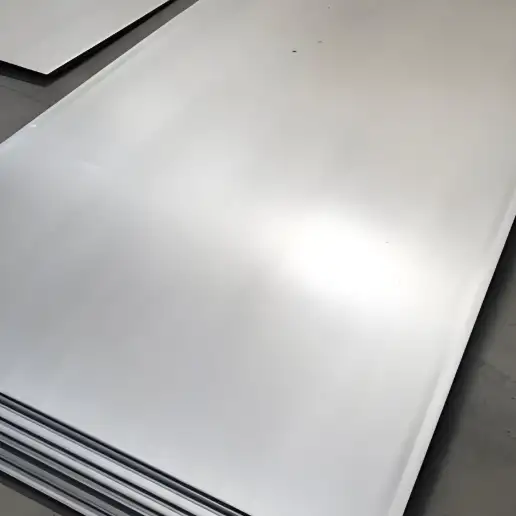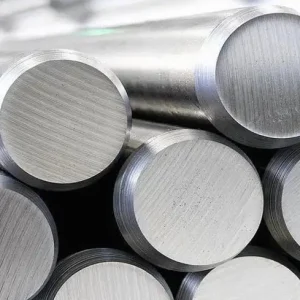Alloy 2205 duplex stainless steel plate (UNS S32205 / S31803, EN 1.4462) delivers a rare mix of high strength, excellent resistance to pitting and stress-corrosion cracking, and good weldability — making it the preferred plate choice for aggressive chloride environments in oil & gas, chemical processing, desalination, and marine service. Compared with common 300-series grades, 2205 reduces wall thickness for the same strength while improving localized corrosion resistance, giving lower life-cycle cost in many demanding applications.
Who should specify 2205 plate
Specifiers who need higher strength than 316/317L and better resistance to pitting and chloride stress-corrosion cracking — while keeping fabrication and welding compatible with conventional stainless steel practice — should strongly consider Alloy 2205 plates. Typical decision drivers include elevated chloride exposure, sulfide environments in oil & gas, and places where weight or wall-thickness reduction matters without compromising toughness.
What is Alloy 2205 duplex stainless steel plate?
Alloy 2205 is a duplex stainless steel: its microstructure contains a nearly balanced mixture of austenite and ferrite (roughly 50/50 when processed correctly). This two-phase structure gives duplex grades their signature combination of tensile strength (higher than common austenitic grades) and good toughness, plus enhanced resistance to chloride-induced localized corrosion. 2205 evolved to solve problems encountered with 300-series stainless steels in chloride-rich and stressed environments; widespread adoption started in the late 20th century and expanded across chemical processing, offshore, and power industries.
Chemical composition
The table below shows the commonly quoted composition ranges for Alloy 2205 (note: exact limits depend on specification and mill certificate).
| Element | Typical range / max (%) |
|---|---|
| Chromium (Cr) | 21.0 – 23.0 |
| Nickel (Ni) | 4.5 – 6.5 |
| Molybdenum (Mo) | 2.5 – 3.5 |
| Nitrogen (N) | 0.14 – 0.20 |
| Carbon (C) | ≤ 0.03 |
| Manganese (Mn) | ≤ 2.0 |
| Silicon (Si) | ≤ 1.0 |
| Phosphorus (P) | ≤ 0.03 – 0.035 (spec-dependent) |
| Sulfur (S) | ≤ 0.02 |
| Iron (Fe) | Balance |
Why these elements matter (short notes):
-
Chromium & Molybdenum: create strong passive film and pitting resistance.
-
Nitrogen: raises strength and stabilizes austenite; greatly improves pitting resistance when combined with Mo and Cr.
-
Nickel: stabilizes austenite and improves toughness/weldability.
-
Low carbon: limits carbide precipitation and improves resistance to intergranular corrosion after welding.
(Composition ranges and the nitrogen emphasis shown here match industry data for 2205 duplex composition used in standard mill certifications).
Mechanical and physical properties (typical / minimum values)
| Property | Typical / minimum (plate, annealed) |
|---|---|
| Ultimate tensile strength (Rm) | ~95 ksi (≈ 655 MPa) (typical min) |
| 0.2% Yield strength (Rp0.2) | ~65 ksi (≈ 450 MPa) (typical min) |
| Elongation (in 2 in / 50 mm) | ≥ 25% |
| Hardness (Brinell, max) | ≤ ~290 HB |
| Density | 0.278 lb/in³ (≈ 7.7 g/cm³) |
| Useful temperature range | Useful up to ~600°F (≈315°C); not recommended for continuous service at significantly higher temperatures due to microstructural changes |
| Impact toughness | Good notch toughness down to below −40°F (≈ −40°C) when processed properly |
These mechanical values are minimum / typical values provided in standard product data for 2205 plate and reflect why designers can often reduce wall thickness compared to 300-series alloys.
Standard equivalents and product specifications
Common industry identifiers you may encounter for 2205 plate:
-
UNS S32205 and UNS S31803 — (note: S32205 is the “low-carbon / higher nitrogen” version frequently used for plate).
-
EN / W. Nr. 1.4462 — common European duplex designation.
-
ASTM / ASME standards for plate and sheet: A240 / SA-240 (plate for pressure vessels and general metal plate), A276, A479, A789, A790 for different product forms and applications.
-
NACE / ISO references for sour-service assessments are commonly cross-referenced when the application involves H₂S or sulfide environments.
When purchasing, always request mill certificates (MTC) showing chemical analysis and mechanical test results; for critical service, request the duplex phase balance verification and NDE appropriate to the application.
Plate sizes, weight table and common tolerances
2205 plate is produced in hot-rolled and cold-rolled forms and is available in a wide range of thicknesses and plate sizes. Below is a practical quick-reference — use this for early estimating only; confirm exact supplier stocks and mill tolerances.
Density used for weight estimate: 7.7 g/cm³ (0.278 lb/in³)
| Nominal thickness (mm) | Width (mm) typical | Length (mm) typical | Weight (kg/m²) |
|---|---|---|---|
| 3.0 | 1500 | 3000 | 23.1 |
| 6.0 | 1500 | 3000 | 46.2 |
| 10.0 | 1500 | 3000 | 77.0 |
| 12.5 | 1500 | 3000 | 96.3 |
| 20.0 | 1500 | 3000 | 154.0 |
| 25.0 | 1500 | 3000 | 192.5 |
How to calculate quickly: Weight (kg) = thickness (m) × width (m) × length (m) × density (7,700 kg/m³).
Common finishes for plate: 2B / cold-rolled gloss, hot-rolled mill finish, polished / bright for decorative or hygienic uses. Typical plate tolerances follow ASTM / EN standards for thickness and flatness — consult the mill sheet for precise limits. (The density and calculation approach are standard in duplex data sheets.)
Corrosion resistance and performance metrics
Key strengths of 2205:
-
Superior pitting and crevice corrosion resistance compared with 304/316 — often expressed through PREN (Pitting Resistance Equivalent Number) which incorporates Cr, Mo and N. Typical PREN for 2205 is around ~35 while 316 sits near 24; higher PREN correlates with better localized corrosion resistance. The higher nitrogen and molybdenum content make a big difference in chloride environments.
-
High resistance to chloride stress corrosion cracking (SCC) — duplex microstructure and lower nickel content improve SCC robustness versus austenitic stainless steels.
-
Good general corrosion resistance in many acidic and alkaline process streams, often outperforming 316/317L in chloride-laden service.
Limitations / cautions:
-
Not recommended for continuous service at high temperatures (>~315°C / 600°F) because prolonged exposure alters phase balance and reduces corrosion resistance.
-
Weld procedure control and correct post-weld practices (e.g., controlled heat input, selection of filler metal like E2209 / ER2209) are important to maintain duplex balance and avoid embrittlement in the heat-affected zone.
Fabrication, welding and heat treatment
-
Forming: Duplex 2205 is stronger than common austenitics; tooling loads will be higher. Use smaller bend radii appropriate for the grade and pre-heat only when specified.
-
Welding: Use duplex-compatible filler metals (e.g., ERNiCrMo-3 family or duplex fillers like ER2209 / E2209) to restore a proper ferrite–austenite balance in the weld. Excessive heat input or slow cooling can shift the microstructure and increase undesirable intermetallic phases; controlled heat input is crucial.
-
Post-weld treatment: In many cases, no solution anneal is required after careful welding; however, for critical service or heavy section welds, post-weld heat treatment and PWHT may be specified by the engineer.
-
Non-destructive testing: For pressure or safety applications, radiography, ultrasonic testing or dye-penetrant inspections are commonly used; for sour service (H₂S) consult NACE requirements and material NDT plans.
-
Machining: Higher strength provides slower metal removal rates; use robust tooling and appropriate coolant.
Typical industrial applications
2205 plate is used where high strength and localized corrosion resistance are required without the expense of super-duplex grades. Common applications include:
-
Heat exchangers and piping in chemical plants handling chlorides and halide-containing media.
-
Offshore oil & gas topside equipment, risers, and flowlines where chloride resistance and H₂S performance matter.
-
Desalination plants (pre-treatment and brine lines).
-
Flue-gas desulfurization (FGD) systems in power plants.
-
Pulp & paper digesters and bleaching equipment.
-
Marine hardware, saltwater ballast and pump components.
2025 Market price snapshot: USA, Europe, China
Note: stainless plate prices fluctuate with raw-material markets (nickel, molybdenum, scrap), order size, surface finish, certification, and logistics. The table below gives indicative 2025 ranges collected from industry price listings and merchant quotations — use these only for budgeting; request firm quotes for purchase.
| Region | Typical 2205 plate price (per kg or per tonne) — 2025 indicative |
|---|---|
| China (FOB / domestic) | ~US$7.5 – $11 / kg (≈ US$7,500 – $11,000 / tonne) — lower end for hot-rolled coil/plate in bulk; higher for certified plate and small lots. |
| USA (merchant / mill) | ~US$10 – $14 / kg (≈ US$10,000 – $14,000 / tonne) depending on stock location, certification, and finishes. |
| Europe (mill / stockist) | ~US$9 – $13 / kg (≈ US$9,000 – $13,000 / tonne) — premium on small orders and fast delivery. |
Buying tips: ask suppliers for (1) up-to-date mill certificates, (2) exact finish and surface condition (2B / HR / polished), (3) shipping incoterm and lead time, (4) NDT/traceability if required. Price can swing significantly with nickel and molybdenum markets and freight costs; order consolidation and longer lead times typically reduce unit cost.
FAQs
-
Is 2205 stronger than 316 stainless steel?
Yes, 2205’s yield and tensile strengths are substantially higher than 316, allowing reduced wall thickness in many designs. -
Can you weld 2205 plate with common stainless fillers?
You should use duplex-specific or carefully selected nickel-based fillers (e.g., ER2209) to retain duplex balance in the weld. Improper filler or excessive heat input can reduce corrosion performance. -
Is 2205 suitable for sour oil & gas service (H₂S)?
2205 has better sulfide stress-cracking resistance than many austenitics, but sour-service approval depends on exact H₂S partial pressure, temperature and NACE/ISO criteria; perform a project-level assessment. -
What is the effect of temperature on 2205?
It performs well up to ~315°C (600°F). Above that, phase instability and precipitate formation reduce corrosion resistance and toughness. -
Does 2205 need special picking for surface finish?
For hygienic or decorative use request polished finishes. For industrial service 2B or hot-rolled finishes are typically acceptable. -
How does 2205 compare to super-duplex (e.g., 2507)?
Super-duplex grades (2507 family) have higher Cr/Mo/N and PREN and are used for more aggressive pitting/chloride service; 2205 is often the cost-effective middle ground. -
Can I buy small quantities?
Yes, MWAlloys and many stockists offer cut-to-size plates, though unit price rises for small, certified lots. -
How to check authenticity on delivery?
Verify mill test certificate (chemical + mechanical), check stamping/heat number vs certificate, and for critical parts require independent testing or positive material identification (PMI). -
Is cold-forming possible for 2205?
It can be formed, but higher strength requires heavier press capacity and may need larger bend radii than 304/316. -
Typical lead time for standard plate from MWAlloys?
Lead time depends on stock and quantity, MWAlloys maintains inventory for rapid shipment on common sizes; request current stock confirmation for firm ETA.






